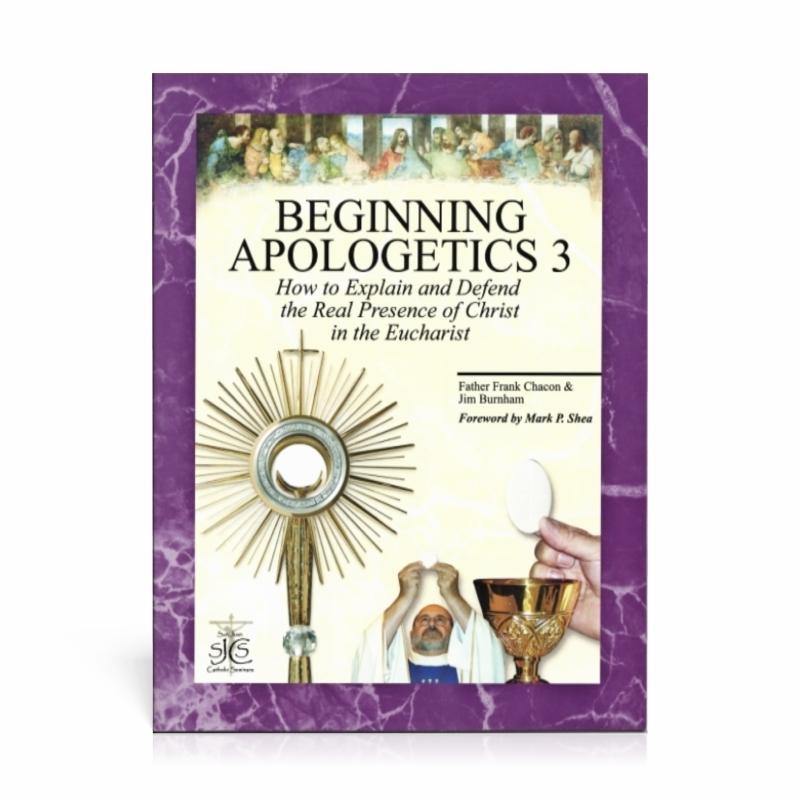Beginning Apologetics 3
Beginning Apologetics 3
Couldn't load pickup availability
How to Explain and Defend the Real Presence of Christ in the Eucharist
In 1862, St. John Bosco had a remarkable dream. He saw the Catholic Church as a mighty flagship in the midst of a great battle. Smaller enemy ships were bombarding it with books and pamphlets, bombs and cannons, and trying to ram it off course. At the same time, huge waves and fierce winds buffeted the flagship. At the helm, the Pope strained every muscle to steer his ship between two mighty columns in the sea. On the smaller column stood a statue of the Blessed Virgin Mary. On the other, far loftier column, was a large Host. In spite of all adversity, the Pope anchored the flagship to thick chains hanging from the two columns. At that, the enemy ships panicked and fled, while the wind and seas grew calm.
St. John Bosco explained that the Church will endure grave trials and persecutions. The Church’s enemies will try their utmost to destroy her. But two things will preserve the Church in that hour: devotion to Mary and frequent Communion.
Bosco’s vision illustrates that the greatest treasure in the Catholic Church is the Eucharist. In it, Jesus humbly assumes the appearance of bread and wine, proving his desire to be bodily connected to us.
Because it is Jesus himself, the Eucharist is the heart of the Catholic faith. The new Catechism of the Catholic Church calls the Eucharist the "source and summit of the Christian life" and the "sum and the summary of our faith" (CCC, sections 1324 and 1327). It’s hard to imagine that any Catholic could misunderstand the central doctrine of his faith.
However, according to an alarming 1992 Gallup poll, the majority of Catholics are confused in their beliefs about Christ’s presence in the Eucharist:
- 30% believe they are really and truly receiving the body, blood, soul and divinity of the Lord Jesus Christ under the appearance of bread and wine.
- 29% believe they are receiving bread and wine that symbolize the body and blood of Jesus.
- 10% believe they receive bread and wine in which Jesus is also present.
- 24% believe they are receiving what has become Christ’s body and blood because of their personal belief.
Any well-informed Catholic will recognize that only the first option, chosen by the 30 percent, represents true Catholic teaching. The other options represent various Protestant beliefs. In other words, nearly 70 percent of all Catholics in this country hold erroneous beliefs about Christ's presence in the Eucharist.
The problem increases dramatically among younger Catholics. According to a more recent New York Times and CBS poll of Catholics who attend Mass regularly, the number of Catholics who accept the Real Presence decreases as age decreases:
- Age 65 and over: 51% believe in the Real Presence
- Age 45 - 64: 37% believe in the Real Presence
- Age 30 - 44: 28% believe in the Real Presence
- Age 18 - 29: 17% believe in the Real Presence
Contents
- Forward by Mark P. Shea
- Introduction
- What Does the Church Teach About the Eucharist?
- Three Ways Jesus is Present
- Why Should We Believe in the Real Presence?
- The Biblical Basis for the Real Presence
- The Eucharist Prefigured in the Old Testament
- The Eucharist Fulfilled in the New Testament
- The Historical Basis for the Real Presence
- Evidence from the Early Church Fathers
- Evidence from History
- Evidence from Eucharistic Miracles
- A Saint's Summary
- I Believe! Now What Should I Do?
- Appreciate the Eucharist More Fully
- Receive the Eucharist More Fruitfully
- Pass the Faith on to Our Children More Permanently
- Evangelize our Separated Brethren More Effectively
- A Saint's Reflection
- Conclusion
- Holy Communion Prayers
- Prayer of St. Thomas Aquinas (before Communion)
- Prayer of St. Thomas Aquinas (after Communion)
- Pange Lingua (Tantum Ergo)
- Adoro Te (translated by Gerard Manley Hopkins, S.J.)
- Glossary of Terms
- Recommended Resources
Authors: Father Frank Chacon & Jim Burnham Format: 8.5x11" softcover. 40 pages
Share



